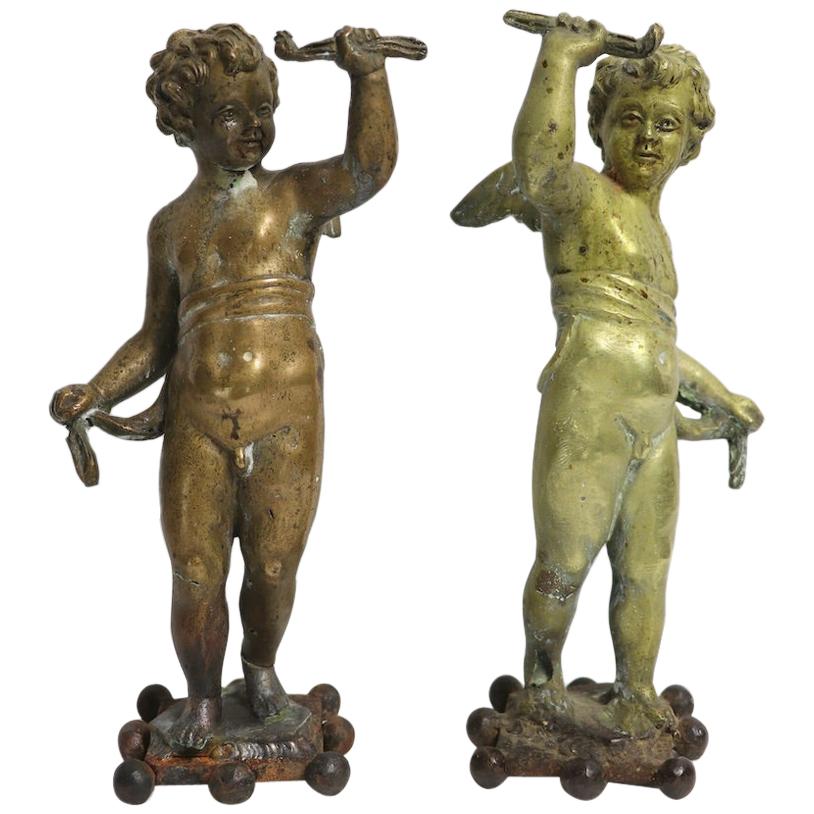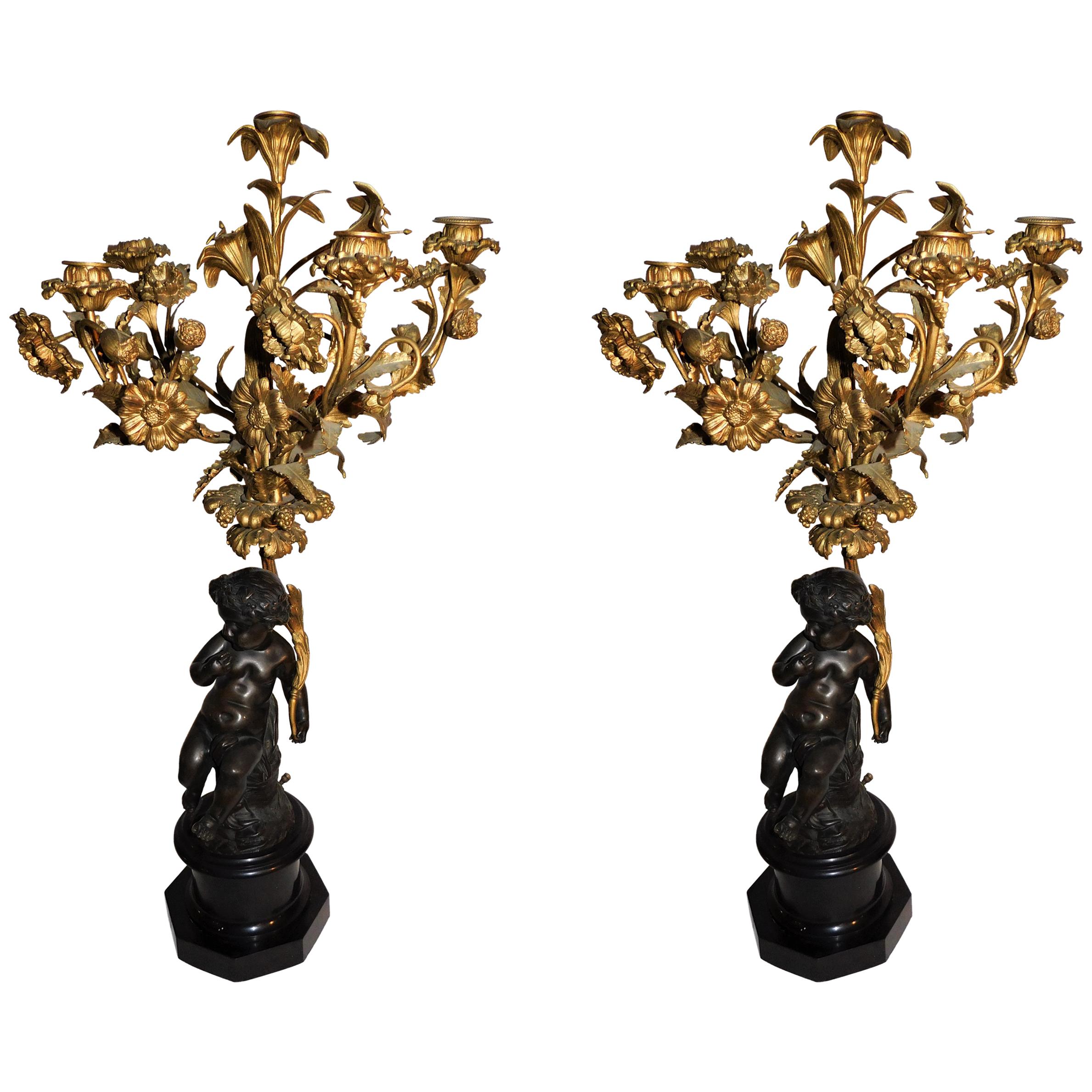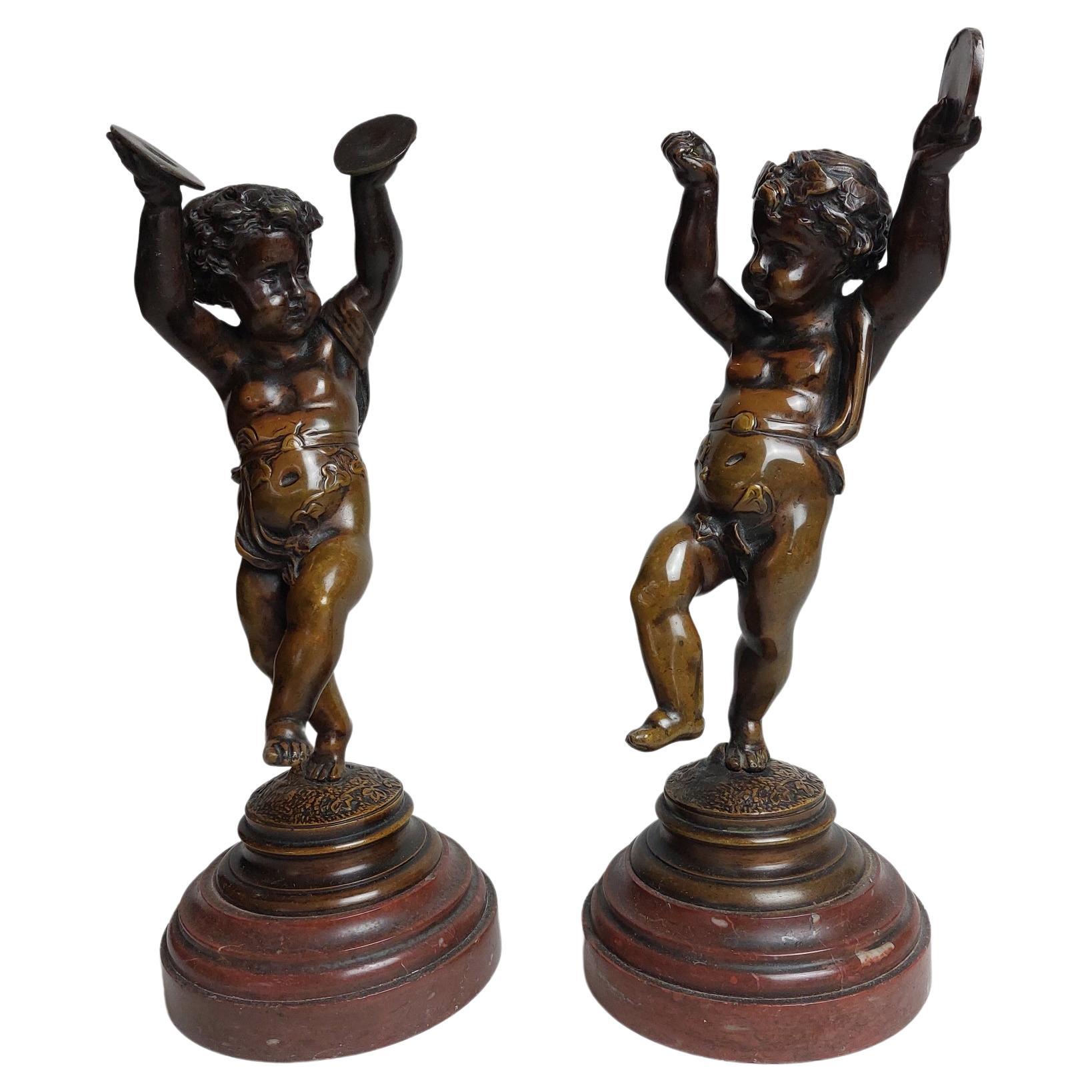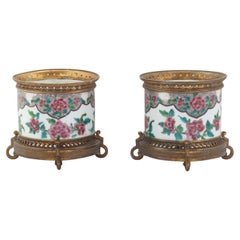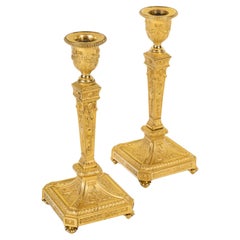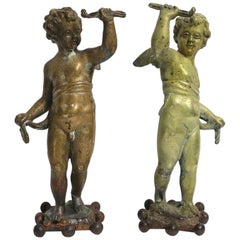
"Flora" and "Grapevine", a French 19th Century Pair of Putti
View Similar Items
Want more images or videos?
Request additional images or videos from the seller
1 of 7
"Flora" and "Grapevine", a French 19th Century Pair of Putti
About the Item
- Dimensions:Height: 5.91 in (15 cm)Diameter: 3.94 in (10 cm)
- Sold As:Set of 2
- Style:Neoclassical (In the Style Of)
- Materials and Techniques:
- Place of Origin:
- Period:
- Date of Manufacture:circa 1880
- Condition:Wear consistent with age and use.
- Seller Location:Saint-Ouen, FR
- Reference Number:1stDibs: LU2612335395972
About the Seller
4.9
Vetted Seller
These experienced sellers undergo a comprehensive evaluation by our team of in-house experts.
1stDibs seller since 2017
56 sales on 1stDibs
Typical response time: 1 hour
More From This SellerView All
- French 19th Century Pair of Porcelain Cache-PotsLocated in Saint-Ouen, FRPair of polychromed hand painted porcelain with Japonisme floral decoration Ormolu-mounted with open-worked base and rim Louis XVI Style circa 1880.Category
Antique 1870s French Chinoiserie Planters, Cachepots and Jardinières
MaterialsOrmolu
$1,923 Sale Price / set20% Off - A Very Fine Quality 19th Century French Pair of CandlesticksLocated in Saint-Ouen, FRVery Fine French 19th Century Pair of Candlesticks In ormolu, very finely chiseled and decorated with knotted garlands, branches of leafy flowers, spokes of hearts, leaves of water...Category
Antique 1870s French Louis XVI Candlesticks
MaterialsOrmolu
- A French 19th Century Pair of Louis XIV Style StoolsLocated in Saint-Ouen, FRA French 19th Century Pair of Large Rectangular Stools natural and carved wood. The 4 sheaths feet carved and linked by a stretcher. Louis XIV Style Napoléon III Period Circa 1880...Category
Antique 1880s French Louis XIV Stools
MaterialsBeech
- French 19th Century Pair of Lacquered Bamboos Japonisme VasesBy Ferdinand Barbedienne, Edouard LievreLocated in Saint-Ouen, FRA 19th French century pair of Lacquered Bamboos Japonisme vases. An amazing pair of tall cylindrical bamboo vases decorated in Japanese Gold and Sil-ver Hiramaki-E Lacquer with Pavilions in The Mist and Weaving Figures, Flown Over by a Pair of Cranes. Enclosed in a Sino-Japanese Inspiration Golden and Brown Patina Bronze Mount Featuring Elephant Heads, Partially Openwork Branches and Salamanders Forming Side Handles. Circa 1870 Attributed to Édouard Lièvre (1828-1886) and Ferdinand Barbedienne (1810-1892) Édouard Lièvre (1828-1886) is one of the most talented and prolific designer and industrialist of the 19th Century, his repertoire is sometimes Sino-Japanese or Neo-Renaissance, whether in furniture or works of art, we can note in particular the parade bed of Valtesse de La Bigne, furniture commissioned by the painter Édouard Detaille or even Sarah Bernhardt, and the famous works in collaboration with Maison Christofle or those in gilded bronze and cloisonné enamel edited by Ferdinand Barbedienne, presented at the Universal Exhibitions in 1878, 1889 and 1900. He was both a draftsman, painter, illustrator, engraver, ornamentalist and cabinetmaker, first trained in the studio of the painter Thomas Couture, Lièvre was then fully immersed in the world of decoration, creation and ornamentation and provides designs for manufacturers and merchant-publishers. Often assisted by his brother Justin, he first produced works of art for his own apartment, seeking out the finest craftsmen to execute his designs for bronzes, ceramics, fabrics and luxury furniture from great virtuosity and great taste. He then collaborated with the cabinet-maker Paul Sormani, as well as haberdasher merchants such as the Escalier de Cristal, bronziers such as Maison Marnyhac and especially Ferdinand Barbedienne as on our vases with bronze mounts characteristics of Edouard Lièvre's work. Born in 1810, died in Paris in 1892, Ferdinand Barbedienne, the most important caster of bronze pieces of art during the second half of the 19th Century, created and directed in Par-is one of the major artistic foundries of his time. Barbedienne specialized in classical reproductions, whose models were exposed in famous European museums. Their illustrated catalogues included many diverse objects such as busts, ornemental sculpture (clocks, candelabras, cups) sometimes even life-sized and bronzes for furniture. Apart from his own produc-tion, Barbedienne worked for the most renowned sculptors such as Barrias, Clésinger and Carrier-Belleuse. All his works were highly esteemed and he, himself honored by contemporary critics. At the London exhibition in 1851 Barbedienne’s firm won two « Council medals ». At the 1855 Universal Exhibition, he won a medal of honor. The success of Barbedienne’s firm brought him many official commissions, such in about 1860, as Barbedienne supplied bronzes for furniture for the Pompeian Villa of Prince Napoléon-Joseph, located avenue Montaigne in Paris. At the London Universal Exhibition of 1862 Barbedienne won medals in three different categories: Furniture, Silversmith work and Artistic bronzes. Barbedienne was made an officer of the Légion d’Honneur in 1867 and Commander in 1878 when he was compared with « a prince of industry and the king of bronze casting ». His glory did not decline with the passage of the time for at the Universal Exhibition of 1889 the critics thanked Barbedienne for the example he set for other bronze-casters by the perfection of his bronzes. “Japonisme” in the second half of the 19th century, was a craze for everything that came from Japan or imitated its style. The word was first coined in a series of articles published by Philippe Burty, from May 1872 to February 1873, in the French magazine “la Renaissance Littéraire et Artistique”. Far from the Academic sphere, artists seeking for new ways of expression, appropriated this discovery. Manet and the impressionists led the way to half a century of enthusiasm for Japanese art, and largely contributed to the esthetical revolution Europe experienced between 1860 and the beginning of the twentieth century. From 1862, The World’s Fairs provoked massive arrivals of fans, kimonos, lacquers, bronzes, silks, prints and books that launched the real era of Japonisme. With those exhibitions, the demand was boosted, the number of merchants and collectors was multiplied, and artists became passionate about this new esthetic. For them, its “primitivism” was probably its most important quality: artists were fond of the Japanese art’s capacity to be close to nature and to reconcile art and society by representing, with a lot of care, the most trivial objects. In painting, Edouard Manet, Mary Cassatt, Degas, Van Gogh, Gauguin were among those who were deeply inspired by Japanese art, affected by the lack of perspective and shadow, the flat areas of strong color, the compositional freedom in placing the subject off-center, with mostly low diagonal axes to the background. The Japanese iris, peonies, bamboos, kimonos, calligraphy, fish, butterflies and other insects, the blackbirds, cranes and wading birds, the cats, tigers, and dragons were endless sources of inspiration, appropriation, and reinterpretation for European artists. The occidental productions were combining styles and artistic conceptions instead of copying Japanese art slavishly. That is what brings to light the comparison between the artworks of Kitagawa Utamaro and Degas, of Katsushika Hokusai and Van Gogh The World’s Fairs of 1851 and 1862 in London, those of 1867, 1878, 1889 and 1900 in Paris, of 1873 in Vienna and of 1904 in Saint Louis presented a number of “Japanese-Chinese” installations with earthenware, bronzes, screens and paintings and attracted the largest amounts of visitors In Vienna, the “Japanese village...Category
Antique 1870s French Japonisme Vases
MaterialsBronze
$42,250 Sale Price / set35% Off - French 19th Century Neogothic InkwellLocated in Saint-Ouen, FRDiana the Huntress A Louis Philippe Neo-Gothic Style Ormolu Inkwell Rectangular in brown patina bronze and gilt bronze. The tier presents in its center a statuette of Diana the ...Category
Antique 1850s French Napoleon III Inkwells
MaterialsBronze, Ormolu
- 19th Century French Lacquered Wood ChandelierLocated in Saint-Ouen, FRA 19th century French polychromed lacquered wood eight-light chandelier Lacquered gloss cream wood with green, red and brown highlights Contained vase ending in foliated seed welcoming eight arms forming semicircles. The top has a frieze of red flowers in green interlacing and is topped with leaves and a painted egg cream...Category
Antique 1890s French Louis XVI Chandeliers and Pendants
MaterialsWood
$5,738 Sale Price30% Off
You May Also Like
- Pair of 19th Century Bronze PuttiLocated in Brighton, SussexA fine quality pair of 19th century classical bronze seated putti, reading and writing, mounted on square rouge marble plinths and engraved gilded ormolu bases.Category
Antique 19th Century French Figurative Sculptures
MaterialsMarble, Bronze
$8,302 / set - Pair of 19th Century Brass Winged PuttiLocated in New York, NYWonderful pair of 19th century brass, or bronze, winged putti figures - European, probably Italian or French in origin. Each figure has been later mounted on iron square bases, both ...Category
Antique 19th Century French Rococo Revival Figurative Sculptures
MaterialsBrass, Bronze, Iron
$1,200 / set - Pair of Bronze Plaquettes with Putti, Signed Clodion, French, 19th CenturyBy Claude Michel ClodionLocated in Kensington, MDIn the first plaquette the putti drink wine, eat grapes, make music and wrestle in a field with a round temple in the background. Signed CLODION In the second plaquette, young sat...Category
Antique Mid-19th Century French Neoclassical Figurative Sculptures
MaterialsBronze
- 19th Century Bronze Putti's a PairLocated in San Francisco, CABeautiful pair of 19th century bronze putti's. They each measure 8 inches high by 3 inches wide. Incredible detail in these two beauties.Category
Antique 19th Century European Figurative Sculptures
MaterialsBronze
$1,250 / set - French, 19th Century Bronze Gilt PuttiLocated in Delft, NLFrench 19th century bronze gilt putti A set of bronze putti figures on a square marble base. A torch and a flute carrying putti, which are graceful objec...Category
Antique 19th Century French Figurative Sculptures
MaterialsMarble, Bronze
$2,404 / set - Small French 19th Century Bronze Statuette of a PuttiLocated in Delft, NLA small French 19th Century bronze statuette of a putti A small French bronze statuette of a putti playing the flute standing on a cl...Category
Antique 19th Century French Figurative Sculptures
MaterialsBronze
Recently Viewed
View AllMore Ways To Browse
French Neoclassical Figurative
Gods Love
Love Spell
Life Size Religious Angle
Pleasant Folk Art Friends
Robert Colinet
Wallmounted Back
Napoleons Fine Art
Cast Putti
Pair Torso Sculpture
Clodion Collection
Butterfly And Girl Art Deco
Marble Art Work
Bronze Goat Mounts
Art Deco Bronze Dancing Female
German Art Deco Nude
Antique Ancient Roman Bronze
Ceramic Bear Italian

